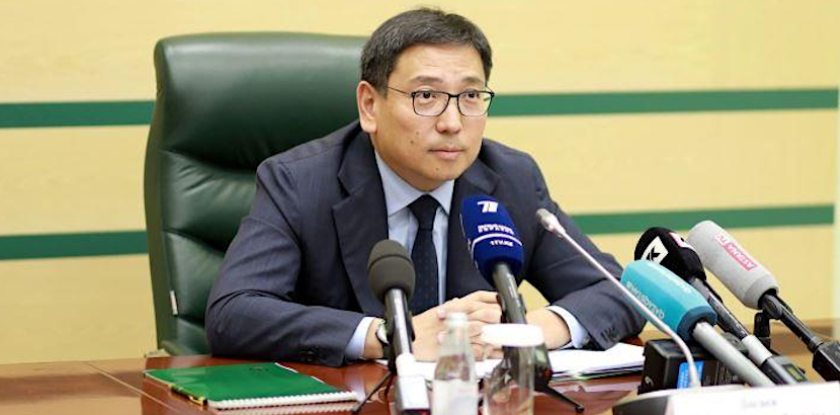Shortly before the collapse of the world oil market and the beginning of the COVID-19 pandemics, the National Bank of the Republic of Kazakhstan had reported on the successful completion of the special op called «an independent assessment of the tier-two banks’ asset quality» (AQR).
Since we have already devoted many a critical material to this subject (Asset Quality Review), we will only say that the project has been completed, deemed successful and, judging by the statement of the National Bank and the Agency for Regulation and Development of the Financial Market of the Republic of Kazakhstan, has established that the local banking system is quite healthy and stable.
Let us remind you that these statements had already been made by the Deputy Chairman of the National Bank and by First Deputy Chairman of the Agency for Regulation of Development of the Financial Market Oleg Smilyakov (highlighted text taken from the original).
«The results of the AQR as well as the measures to increase the quality of the assets and support the TTBs capitalisation implemented after April 1, 2019 until now confirm that, on the systemic level as well as on the level of individual banks participated in the AQR, there is no deficit of capital. The risks for the clients of the banks that have participated in the AQR are absent due to the fact that, based on the implemented measures, the level of capital adequacy in all the banks is higher than is required by the regulator. Based on the results of the AQR, we have determined the directions of increasing the quality of the processes, the data, the policies and the procedures. The full implementation of the recommendations and the corrective measures will endure the protection of the clients’ interests, prevent the accumulation of risks and increase the stability of the system against the internal and external shocks».
In our opinion, the National Bank and the Agency for Regulation and Development of the Financial Market have conducted the «independent assessment of the TTBs’ asset quality» quite well. Of course, they did not tell the whole truth. They have only voiced what is convenient for Akorda. Let us explain what we mean.
Here is another quote from Slomyakov’s.
«The program incorporated 14 banks, 87% of the assets of the entire banking sector and 90% of the entire loan portfolio». The AQR involved more than 500 employees of the auditing and consulting companies, more than 60 employees of the National Banks and more than 70 independent assessment companies».
In other words, generally speaking, the optimistic results of the AQR program are applied to 14 Kazakh banks only. Meanwhile, Kazakhstan currently has 27 operating financial institutes. The «lucky» 14 include Halyk Bank of Kazakhstan JSC, Sberbank JSC Subsidiary Office, Kaspi Bank JSC, Forte Bank JSC, First Heartland Jysan Bank JSC, Bank RBK JSC, Alfa Bank JSC Subsidiary Office, Altyn Bank JSC, Bank Home Credit JSC Subsidiary Office, Bank VTB (Kazakhstan) JSC Subsidiary Office, Bank CentreCredit JSC, ATFBaqnk JSC, Eurasian Bank JSC, Nurbank JSC.
The AQR program did not include Zhilstroysberbank of Kazakhstan JSC, Citibank Kazakhstan JSC Subsidiary Office, Bank of China in Kazakhstan JSC Subsidiary Office, Industrial and Commercial Bank of China in Almaty JSC, Tengri Bank JSC, Bank Kassa Nova (ForteBank JSC Subsidiary Office), KZI Bank JSC Subsidiary Office, Capital Bank Kazakhstan JSC, AsiaCredit Bank JSC, Shinhan Bank Kazakhstan JSC, Islamic Bank Al Hilal JSC, Islamic Bank Zaman-Bank JSC, NB of Pakistan in Kazakhstan JSC Subsidiary Office.
The reasons why the National Bank of Kazakhstan chose not to apply the AQR program to all the banks are clear — the regulator had been saving time, money and nerves.
It is not hard to notice that, among the 13 Kazakh banks that did not go through the AQR (apart from the state-owned Zhilstroysberbank of Kazakhstan and the banks controlled by the large foreign banking groups), there are two small financial institutes that have been experiencing problems for quite some time. We are talking about Capital Bank of Kazakhstan and AsiaCredit Bank JSC. And the fact that they are «drowning» has been know at the market for a long time. The only thing that was not clear was who or what was keeping them afloat.
The passivity of the National Bank and the Agency for Regulation and Development of the Financial Market are all the more astounding since the state has got a gigantic experience in «saving» much larger financial institutes starting from BTA Bank and ending with Tsesnabank.
Moreover, when Tengri Bank JSC refused to merge with Capital Bank Kazakhstan and AsiaCredit Bank JSC, the National Bank of the Republic of Kazakhstan did nothing that could harm the last two.
It is worth mentioning that Shadiyev Orifdzhan Kabulovich is the sole shareholder of both banks. He owns 100% of the shares in both Capital Bank Kazakhstan JSC as well as AsiaCredit Bank JSC.
By the by, he purchased the last one from Nurbol Sultan, a son of the late Sarbay Kalmurzayev, who had to sell his business when he, due to his father’s death, lost his competitive abilities within the Kazakh ruling elite.
Now then, based on the information provided by our insiders, Mr. Shadiyev has got a very influential silent partner. We are talking about Nurbol Nazarbayev, a son of the First President’s brother Bolat Nazarbayev.
We do not know exactly how the shares of the two banks are divided between the Leader of the Nation’s nephew and Orifdzhan Shadiyev, but the mere thing that the National Bank of the Republic of Kazakhstan didn’t dare to make these banks go through the AQR speaks volumes.
For instance, it explains why Capital Bank Kazakhstan JSC and AsiaCredit Bank JSC that have been experiencing financial problems for a long time and have a highly poor-quality loan portfolio, have never been punished or pressurised which, on the back of the Kazakh banking sector’s tumultuous history, looks like and absolute nonsense.
 Bolat Nazarbayev with his son and brother. Photo from Respublika archives
Bolat Nazarbayev with his son and brother. Photo from Respublika archives






